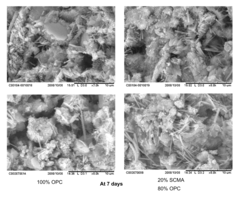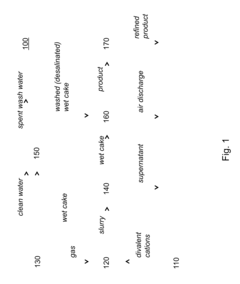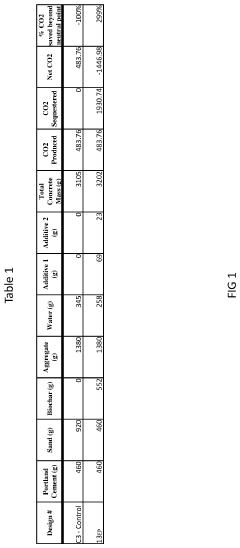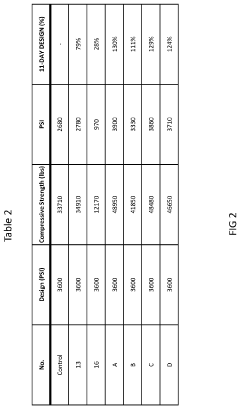Carbon-negative Concrete in Reducing Environmental Footprint
OCT 10, 202510 MIN READ
Generate Your Research Report Instantly with AI Agent
Patsnap Eureka helps you evaluate technical feasibility & market potential.
Carbon-negative Concrete Background and Objectives
Concrete production is one of the most carbon-intensive industrial processes, accounting for approximately 8% of global CO2 emissions. This significant environmental impact has driven the construction industry to seek innovative solutions that not only reduce emissions but potentially create carbon-negative alternatives. Carbon-negative concrete represents a revolutionary approach that aims to sequester more carbon dioxide than is emitted during its production and lifecycle, effectively transforming a major climate problem into part of the solution.
The evolution of concrete technology has progressed from traditional Portland cement-based formulations to low-carbon alternatives, and now toward carbon-negative solutions. This progression reflects growing environmental consciousness and regulatory pressures to decarbonize the construction sector. The concept of carbon-negative concrete emerged in the early 2010s but has gained substantial momentum in the past five years as climate change mitigation has become increasingly urgent.
Current carbon-negative concrete technologies employ various mechanisms to achieve negative emissions, including the incorporation of industrial by-products like fly ash and slag, the use of novel binders that require less energy to produce, and the integration of carbon capture during the curing process. These approaches represent a fundamental shift in how we conceptualize building materials, moving from merely reducing harm to actively benefiting the environment.
The primary technical objective of carbon-negative concrete research is to develop commercially viable formulations that maintain or exceed the performance characteristics of traditional concrete while achieving net carbon sequestration. This includes ensuring comparable strength, durability, workability, and cost-effectiveness. Secondary objectives include optimizing production processes to minimize energy consumption, developing scalable manufacturing methods, and creating standardized testing protocols to verify carbon negativity claims.
Long-term objectives extend beyond technical performance to include market transformation. The ultimate goal is to establish carbon-negative concrete as the industry standard rather than a niche alternative, thereby dramatically reducing the environmental footprint of the construction sector. This requires not only technological innovation but also policy support, supply chain development, and education of stakeholders throughout the building industry.
The technological trajectory suggests several promising pathways forward, including biomimetic approaches inspired by natural carbon-sequestering processes, advanced carbonation techniques that accelerate CO2 absorption, and hybrid systems that combine multiple carbon reduction strategies. As research progresses, the focus is increasingly on solutions that can be implemented at scale in diverse geographical and economic contexts.
The evolution of concrete technology has progressed from traditional Portland cement-based formulations to low-carbon alternatives, and now toward carbon-negative solutions. This progression reflects growing environmental consciousness and regulatory pressures to decarbonize the construction sector. The concept of carbon-negative concrete emerged in the early 2010s but has gained substantial momentum in the past five years as climate change mitigation has become increasingly urgent.
Current carbon-negative concrete technologies employ various mechanisms to achieve negative emissions, including the incorporation of industrial by-products like fly ash and slag, the use of novel binders that require less energy to produce, and the integration of carbon capture during the curing process. These approaches represent a fundamental shift in how we conceptualize building materials, moving from merely reducing harm to actively benefiting the environment.
The primary technical objective of carbon-negative concrete research is to develop commercially viable formulations that maintain or exceed the performance characteristics of traditional concrete while achieving net carbon sequestration. This includes ensuring comparable strength, durability, workability, and cost-effectiveness. Secondary objectives include optimizing production processes to minimize energy consumption, developing scalable manufacturing methods, and creating standardized testing protocols to verify carbon negativity claims.
Long-term objectives extend beyond technical performance to include market transformation. The ultimate goal is to establish carbon-negative concrete as the industry standard rather than a niche alternative, thereby dramatically reducing the environmental footprint of the construction sector. This requires not only technological innovation but also policy support, supply chain development, and education of stakeholders throughout the building industry.
The technological trajectory suggests several promising pathways forward, including biomimetic approaches inspired by natural carbon-sequestering processes, advanced carbonation techniques that accelerate CO2 absorption, and hybrid systems that combine multiple carbon reduction strategies. As research progresses, the focus is increasingly on solutions that can be implemented at scale in diverse geographical and economic contexts.
Market Analysis for Sustainable Construction Materials
The sustainable construction materials market is experiencing unprecedented growth, driven by increasing environmental concerns and regulatory pressures to reduce carbon emissions in the building sector. Currently valued at approximately $299 billion globally, this market is projected to reach $641 billion by 2030, with a compound annual growth rate of 11.4% between 2023 and 2030. Carbon-negative concrete represents one of the fastest-growing segments within this category, with particular momentum in North America, Europe, and increasingly in Asia-Pacific regions.
Consumer demand patterns show a significant shift toward environmentally responsible building materials, with 78% of commercial construction projects now specifying some form of sustainable concrete alternatives. This trend is particularly pronounced in public infrastructure projects, where government procurement policies increasingly mandate carbon footprint considerations. The premium pricing tolerance for carbon-negative concrete has also evolved, with consumers now willing to pay 15-20% more for demonstrably carbon-negative solutions compared to conventional concrete.
Market segmentation reveals distinct adoption patterns across different construction sectors. Commercial buildings lead adoption at 42% market share, followed by infrastructure projects at 31%, residential construction at 18%, and industrial applications at 9%. Geographically, Europe dominates with 38% market share, followed by North America at 32%, Asia-Pacific at 22%, and other regions comprising the remaining 8%.
Key market drivers include increasingly stringent building codes and environmental regulations, with over 60 countries now having specific carbon reduction targets for the construction sector. Carbon pricing mechanisms and tax incentives in major economies have created financial incentives that directly benefit carbon-negative materials. Additionally, green building certification systems like LEED, BREEAM, and WELL have updated their criteria to award significant points for carbon-negative material usage.
Market barriers remain significant despite growing demand. Production scaling challenges limit widespread adoption, with current global production capacity meeting only 3% of potential demand. Cost premiums average 25-30% above traditional concrete, though this gap is narrowing annually. Technical performance concerns persist among conservative stakeholders, particularly regarding long-term durability and performance under extreme conditions.
Future market projections indicate carbon-negative concrete could capture up to 35% of the global concrete market by 2035, representing a potential market value of $217 billion. Growth will likely accelerate as production technologies mature and economies of scale reduce cost differentials. The most promising growth segments include urban infrastructure renewal projects, climate-resilient construction, and high-visibility commercial developments seeking environmental leadership positioning.
Consumer demand patterns show a significant shift toward environmentally responsible building materials, with 78% of commercial construction projects now specifying some form of sustainable concrete alternatives. This trend is particularly pronounced in public infrastructure projects, where government procurement policies increasingly mandate carbon footprint considerations. The premium pricing tolerance for carbon-negative concrete has also evolved, with consumers now willing to pay 15-20% more for demonstrably carbon-negative solutions compared to conventional concrete.
Market segmentation reveals distinct adoption patterns across different construction sectors. Commercial buildings lead adoption at 42% market share, followed by infrastructure projects at 31%, residential construction at 18%, and industrial applications at 9%. Geographically, Europe dominates with 38% market share, followed by North America at 32%, Asia-Pacific at 22%, and other regions comprising the remaining 8%.
Key market drivers include increasingly stringent building codes and environmental regulations, with over 60 countries now having specific carbon reduction targets for the construction sector. Carbon pricing mechanisms and tax incentives in major economies have created financial incentives that directly benefit carbon-negative materials. Additionally, green building certification systems like LEED, BREEAM, and WELL have updated their criteria to award significant points for carbon-negative material usage.
Market barriers remain significant despite growing demand. Production scaling challenges limit widespread adoption, with current global production capacity meeting only 3% of potential demand. Cost premiums average 25-30% above traditional concrete, though this gap is narrowing annually. Technical performance concerns persist among conservative stakeholders, particularly regarding long-term durability and performance under extreme conditions.
Future market projections indicate carbon-negative concrete could capture up to 35% of the global concrete market by 2035, representing a potential market value of $217 billion. Growth will likely accelerate as production technologies mature and economies of scale reduce cost differentials. The most promising growth segments include urban infrastructure renewal projects, climate-resilient construction, and high-visibility commercial developments seeking environmental leadership positioning.
Current Status and Challenges in Carbon-negative Concrete
Carbon-negative concrete technology has made significant strides globally, with pioneering research emerging from academic institutions and industry collaborations. Currently, several commercial-scale projects are operational in North America, Europe, and parts of Asia, demonstrating the technical feasibility of carbon-negative concrete production. These implementations utilize various approaches including carbon capture during cement manufacturing, alternative cementitious materials, and carbon sequestration techniques within the concrete matrix itself.
Despite these advancements, carbon-negative concrete faces substantial technical challenges. The most significant hurdle remains achieving consistent mechanical properties comparable to traditional Portland cement concrete while maintaining carbon negativity. Research indicates that many carbon-negative formulations exhibit slower strength development and higher variability in performance metrics, limiting their application in structural elements where predictable behavior is critical.
Cost factors present another major obstacle, with current production methods for carbon-negative concrete typically resulting in 15-30% higher costs compared to conventional concrete. This premium stems from specialized manufacturing processes, alternative material sourcing, and the energy requirements for carbon capture technologies. The economic viability remains contingent on carbon pricing mechanisms and regulatory frameworks that currently vary significantly across regions.
Scalability represents a persistent challenge, as many promising laboratory techniques have proven difficult to implement at industrial scale. The global concrete industry produces approximately 30 billion tons annually, requiring carbon-negative solutions that can operate at massive scale without disrupting existing supply chains and construction practices. Current production capacity for carbon-negative concrete represents less than 0.1% of global concrete demand.
Geographically, research leadership is distributed unevenly, with significant concentrations in Northern Europe, North America, and East Asia. European initiatives benefit from supportive regulatory environments and carbon pricing mechanisms, while North American research focuses on market-driven solutions and material innovation. Asian developments, particularly in China and Japan, emphasize industrial-scale implementation and integration with existing infrastructure.
Regulatory frameworks present both challenges and opportunities, with inconsistent standards for measuring and verifying carbon negativity across jurisdictions. The absence of universally accepted certification protocols has slowed market adoption and complicated international trade in carbon-negative concrete products. Industry stakeholders are actively working with standards organizations to develop consistent methodologies for life cycle assessment and carbon accounting specific to cementitious materials.
Despite these advancements, carbon-negative concrete faces substantial technical challenges. The most significant hurdle remains achieving consistent mechanical properties comparable to traditional Portland cement concrete while maintaining carbon negativity. Research indicates that many carbon-negative formulations exhibit slower strength development and higher variability in performance metrics, limiting their application in structural elements where predictable behavior is critical.
Cost factors present another major obstacle, with current production methods for carbon-negative concrete typically resulting in 15-30% higher costs compared to conventional concrete. This premium stems from specialized manufacturing processes, alternative material sourcing, and the energy requirements for carbon capture technologies. The economic viability remains contingent on carbon pricing mechanisms and regulatory frameworks that currently vary significantly across regions.
Scalability represents a persistent challenge, as many promising laboratory techniques have proven difficult to implement at industrial scale. The global concrete industry produces approximately 30 billion tons annually, requiring carbon-negative solutions that can operate at massive scale without disrupting existing supply chains and construction practices. Current production capacity for carbon-negative concrete represents less than 0.1% of global concrete demand.
Geographically, research leadership is distributed unevenly, with significant concentrations in Northern Europe, North America, and East Asia. European initiatives benefit from supportive regulatory environments and carbon pricing mechanisms, while North American research focuses on market-driven solutions and material innovation. Asian developments, particularly in China and Japan, emphasize industrial-scale implementation and integration with existing infrastructure.
Regulatory frameworks present both challenges and opportunities, with inconsistent standards for measuring and verifying carbon negativity across jurisdictions. The absence of universally accepted certification protocols has slowed market adoption and complicated international trade in carbon-negative concrete products. Industry stakeholders are actively working with standards organizations to develop consistent methodologies for life cycle assessment and carbon accounting specific to cementitious materials.
Current Carbon-negative Concrete Technical Solutions
01 Carbon capture and sequestration in concrete
Technologies that enable concrete to capture and permanently sequester carbon dioxide during the curing process, transforming it from a carbon source to a carbon sink. These methods involve injecting CO2 into concrete mixtures where it reacts with calcium compounds to form stable carbonates, effectively locking away carbon while simultaneously improving concrete strength and durability. This approach can significantly reduce or even reverse the carbon footprint of concrete production.- CO2 Sequestration in Concrete Production: Technologies that capture and store carbon dioxide during the concrete manufacturing process, resulting in carbon-negative concrete. These methods involve injecting CO2 into concrete mixtures where it reacts with calcium compounds to form stable carbonates, effectively sequestering carbon while improving concrete properties. This approach significantly reduces the environmental footprint of concrete production by transforming a carbon-intensive material into one that can act as a carbon sink.
- Alternative Cementitious Materials: Use of alternative materials to replace traditional Portland cement in concrete formulations, resulting in lower carbon emissions. These alternatives include industrial byproducts like fly ash, slag, and silica fume, as well as novel binders derived from natural materials. By reducing the need for energy-intensive clinker production, these substitutes can significantly decrease the carbon footprint of concrete while maintaining or even enhancing performance characteristics.
- Carbon Footprint Measurement and Certification: Systems and methods for accurately measuring, tracking, and certifying the carbon footprint of concrete throughout its lifecycle. These technologies include digital platforms that calculate emissions from raw material extraction through manufacturing, transportation, use, and end-of-life disposal. Such systems enable verification of carbon-negative claims, support carbon credit generation, and provide data for environmental product declarations, helping stakeholders make informed decisions about sustainable concrete options.
- Biomass and Waste Incorporation: Methods for incorporating biomass and waste materials into concrete formulations to reduce carbon footprint. These approaches utilize agricultural residues, wood waste, plastic waste, and other carbon-containing materials as partial replacements for traditional concrete components. The organic materials can be processed into biochar or other forms that sequester carbon while providing functional benefits to the concrete, resulting in products with negative carbon footprints while addressing waste management challenges.
- Enhanced Carbonation Processes: Advanced techniques to accelerate and optimize the carbonation process in concrete, maximizing CO2 uptake and improving material properties. These innovations include specialized curing chambers, catalysts, and process modifications that promote efficient carbon dioxide absorption throughout the concrete matrix. By enhancing the natural carbonation that occurs in concrete over time, these methods can transform conventional concrete into a more effective carbon sink while potentially improving strength and durability.
02 Alternative cementitious materials and binders
Development of novel cement alternatives and supplementary cementitious materials that require less energy to produce and generate fewer emissions than traditional Portland cement. These include geopolymers, alkali-activated materials, magnesium-based cements, and various industrial byproducts like fly ash and slag. By partially or completely replacing conventional cement with these alternatives, the carbon footprint of concrete can be substantially reduced while maintaining or even enhancing performance characteristics.Expand Specific Solutions03 Environmental impact assessment and lifecycle analysis
Methods and systems for quantifying, monitoring, and verifying the environmental impact of concrete throughout its lifecycle. These technologies include sophisticated carbon accounting frameworks, digital tools for tracking emissions, and standardized methodologies for calculating carbon footprints. Such systems enable accurate measurement of carbon negativity claims, facilitate carbon credit generation, and support decision-making for sustainable concrete formulations and applications.Expand Specific Solutions04 Biomass incorporation and biogenic materials
Integration of biomass and biogenic materials into concrete formulations to reduce environmental impact. These approaches include incorporating agricultural waste, wood products, algae, or other plant-based materials that have sequestered carbon during their growth phase. When these materials are used as aggregates, fillers, or precursors for cement alternatives, they bring their embedded carbon benefits to the concrete, potentially creating carbon-negative building materials while providing waste valorization opportunities.Expand Specific Solutions05 Enhanced weathering and mineralization processes
Accelerated carbonation and mineralization techniques that promote the natural weathering processes of concrete materials. These methods leverage the natural tendency of certain minerals to react with atmospheric CO2 over time, but significantly speed up the process through various engineering approaches. By enhancing these natural carbon sequestration mechanisms, concrete can absorb more CO2 throughout its lifetime, potentially offsetting or exceeding the emissions generated during its production.Expand Specific Solutions
Key Industry Players in Carbon-negative Concrete Development
The carbon-negative concrete market is in an early growth phase, characterized by increasing research and development activities as the construction industry seeks sustainable solutions to reduce its environmental footprint. The global market for green concrete is expanding rapidly, projected to reach approximately $40 billion by 2030, driven by stringent carbon regulations and sustainability goals. Technologically, the field remains in development with varying levels of maturity across solutions. Leading players include established companies like Calera Corp. and Ecocem Materials, which are pioneering CO2 conversion technologies, alongside major construction materials providers such as China National Building Material Group and thyssenkrupp. Academic institutions including Shenzhen University and Colorado School of Mines are contributing significant research, while collaborations between industry players and research organizations are accelerating innovation in carbon-capturing cement alternatives.
Calera Corp.
Technical Solution: Calera has developed a pioneering carbon capture and mineralization process that transforms CO2 emissions into calcium carbonate, which can be used as a supplementary cementitious material (SCM) in concrete production. Their technology mimics marine cement formation by capturing CO2 from industrial flue gases and combining it with calcium extracted from seawater or brine. This process not only sequesters carbon but produces a cement-like material that can replace up to 20% of traditional Portland cement. Calera's approach is unique as it addresses both carbon capture and cement production simultaneously, potentially creating a truly carbon-negative concrete solution. The company has demonstrated that for every ton of cement produced using their technology, approximately 0.5 tons of CO2 can be sequestered, making their concrete products net carbon-negative rather than just carbon-neutral.
Strengths: Directly captures and converts CO2 into usable construction materials, creating a closed-loop system. Their process can utilize waste brines from desalination plants as calcium sources, addressing multiple environmental issues simultaneously. Weaknesses: Requires proximity to both industrial CO2 sources and calcium-rich water sources, limiting deployment locations. The technology demands significant energy input, which could offset carbon benefits if not powered by renewable energy.
China Building Materials Academy Co. Ltd.
Technical Solution: China Building Materials Academy (CBMA) has developed a multi-faceted approach to carbon-negative concrete through their Advanced Low-Carbon Cement and Concrete Research Initiative. Their technology focuses on novel clinker substitutes derived from industrial waste streams and naturally occurring minerals that require minimal processing energy. CBMA has pioneered a geopolymer-based binding system that utilizes alkaline activators to transform aluminosilicate materials into durable cementitious compounds without the high-temperature calcination required for traditional cement. Their research has demonstrated carbon reductions of up to 80% compared to conventional concrete. Additionally, CBMA has developed an innovative carbon mineralization technology that accelerates the natural carbonation process in concrete, allowing it to sequester significant amounts of CO2 throughout its service life. The academy has also created specialized admixtures that enhance concrete's carbon absorption capacity while improving durability and performance characteristics. Their integrated approach includes optimizing mix designs based on specific application requirements and local material availability, ensuring both environmental and economic sustainability.
Strengths: Strong research capabilities and extensive testing facilities allow for rapid innovation and validation of new technologies. Their solutions are designed with practical implementation in mind, considering local material availability and existing production infrastructure. Weaknesses: Some of their advanced geopolymer formulations may require more precise quality control than traditional concrete, potentially limiting adoption in less technically sophisticated markets. The long-term performance data for some of their newer technologies is still being accumulated.
Core Patents and Research in CO2 Sequestration Concrete
Reduced-carbon footprint concrete compositions
PatentActiveUS20100313793A1
Innovation
- A method involving the production of a synthetic carbonate component from a divalent cation-containing solution and industrial waste gas containing CO2, which is then incorporated into a reduced-carbon footprint concrete composition, reducing the carbon footprint by sequestering CO2 and avoiding CO2 emissions from conventional cement production.
Carbon negative concrete production through the use of sustainable materials
PatentInactiveUS20230002276A1
Innovation
- Incorporating biochar, a high-carbon residue produced through low-oxygen pyrolysis, into concrete mixtures to sequester carbon and reduce emissions, while optimizing pyrolysis processes to power plants using syngas for self-sustainability and carbon neutrality.
Regulatory Framework and Carbon Credit Opportunities
The regulatory landscape for carbon-negative concrete is rapidly evolving as governments worldwide implement policies to reduce carbon emissions in the construction sector. The European Union's Emissions Trading System (EU ETS) has expanded to include cement production, creating financial incentives for manufacturers to adopt carbon-negative technologies. Similarly, the United States has introduced tax credits through the Inflation Reduction Act specifically targeting carbon capture and utilization in concrete production, offering up to $85 per ton of CO2 permanently sequestered.
National building codes are increasingly incorporating carbon footprint requirements, with countries like France, Sweden, and Finland leading with mandatory life cycle assessments for new construction projects. These regulations create market pull for carbon-negative concrete solutions by establishing clear performance standards and compliance mechanisms. The International Organization for Standardization (ISO) has developed standards for measuring embodied carbon in building materials, providing a unified framework for regulatory compliance across different jurisdictions.
Carbon credit markets present significant economic opportunities for carbon-negative concrete producers. The voluntary carbon market has grown exponentially, with carbon credits for engineered carbon removal solutions commanding premium prices of $200-600 per ton of CO2. Projects utilizing carbon-negative concrete can generate high-quality carbon credits by permanently sequestering CO2 in building structures, creating a secondary revenue stream beyond material sales.
Certification systems like LEED, BREEAM, and DGNB have updated their criteria to award additional points for carbon-negative materials, further incentivizing their adoption in green building projects. These systems create market differentiation opportunities for early adopters of carbon-negative concrete technologies. The Science Based Targets initiative (SBTi) has also recognized carbon-negative materials as a valid strategy for companies to achieve net-zero commitments.
Public procurement policies are emerging as powerful market drivers, with governments in Canada, Norway, and the Netherlands implementing carbon-based procurement criteria for infrastructure projects. These policies create guaranteed demand for low-carbon construction materials, reducing market entry barriers for innovative solutions. California's Buy Clean California Act specifically targets embodied carbon in construction materials for state-funded projects, creating a model being replicated in other regions.
Financial institutions are developing green financing instruments specifically for carbon-negative building projects, with preferential interest rates and extended repayment terms. These mechanisms help overcome the initial cost premium often associated with carbon-negative concrete, accelerating market adoption through improved project economics and risk profiles.
National building codes are increasingly incorporating carbon footprint requirements, with countries like France, Sweden, and Finland leading with mandatory life cycle assessments for new construction projects. These regulations create market pull for carbon-negative concrete solutions by establishing clear performance standards and compliance mechanisms. The International Organization for Standardization (ISO) has developed standards for measuring embodied carbon in building materials, providing a unified framework for regulatory compliance across different jurisdictions.
Carbon credit markets present significant economic opportunities for carbon-negative concrete producers. The voluntary carbon market has grown exponentially, with carbon credits for engineered carbon removal solutions commanding premium prices of $200-600 per ton of CO2. Projects utilizing carbon-negative concrete can generate high-quality carbon credits by permanently sequestering CO2 in building structures, creating a secondary revenue stream beyond material sales.
Certification systems like LEED, BREEAM, and DGNB have updated their criteria to award additional points for carbon-negative materials, further incentivizing their adoption in green building projects. These systems create market differentiation opportunities for early adopters of carbon-negative concrete technologies. The Science Based Targets initiative (SBTi) has also recognized carbon-negative materials as a valid strategy for companies to achieve net-zero commitments.
Public procurement policies are emerging as powerful market drivers, with governments in Canada, Norway, and the Netherlands implementing carbon-based procurement criteria for infrastructure projects. These policies create guaranteed demand for low-carbon construction materials, reducing market entry barriers for innovative solutions. California's Buy Clean California Act specifically targets embodied carbon in construction materials for state-funded projects, creating a model being replicated in other regions.
Financial institutions are developing green financing instruments specifically for carbon-negative building projects, with preferential interest rates and extended repayment terms. These mechanisms help overcome the initial cost premium often associated with carbon-negative concrete, accelerating market adoption through improved project economics and risk profiles.
Life Cycle Assessment of Carbon-negative Concrete Systems
Life Cycle Assessment (LCA) of carbon-negative concrete systems provides a comprehensive framework for evaluating the environmental impacts throughout the entire lifecycle of these innovative construction materials. The assessment typically encompasses raw material extraction, manufacturing processes, transportation, installation, use phase, and end-of-life scenarios, offering a holistic view of environmental performance.
Carbon-negative concrete systems demonstrate unique environmental profiles compared to conventional concrete. Studies indicate that while traditional concrete production generates approximately 0.9 tons of CO2 per ton of cement, carbon-negative alternatives can sequester between 0.1 to 0.5 tons of CO2 per ton of material produced, depending on the specific technology employed. This reversal from emission source to carbon sink represents a paradigm shift in construction materials.
The manufacturing phase analysis reveals significant differences in energy consumption patterns. Carbon-negative concrete typically requires 15-30% less energy during production compared to Portland cement concrete, primarily due to lower calcination temperatures and alternative curing methods. However, certain carbon capture technologies integrated into these systems may introduce additional energy requirements that must be factored into the overall assessment.
Transportation impacts vary considerably based on raw material sourcing. Many carbon-negative concrete formulations utilize locally available industrial byproducts such as fly ash, slag, and silica fume, potentially reducing transportation-related emissions by up to 40% compared to conventional concrete supply chains. This localization effect creates regional variations in the overall carbon footprint that must be accounted for in comprehensive LCA studies.
The use phase of carbon-negative concrete demonstrates enhanced durability metrics in several studies, with projected service lifespans extending 20-35% beyond conventional concrete in similar applications. This longevity factor significantly improves lifecycle performance by reducing replacement frequency and associated environmental impacts. Additionally, the continued carbonation process during the use phase further enhances carbon sequestration potential over time.
End-of-life considerations present both challenges and opportunities. Research indicates that carbon-negative concrete can be recycled with efficiency comparable to conventional concrete, but specialized processing may be required to preserve the carbon sequestration benefits. Some studies suggest that crushed carbon-negative concrete can continue to absorb atmospheric CO2 when used as aggregate, potentially creating secondary carbon benefits beyond the primary application lifecycle.
Sensitivity analyses across multiple LCA studies highlight the importance of regional electricity grid composition, transportation distances, and raw material availability as key variables affecting overall environmental performance. These factors must be carefully considered when evaluating the implementation potential of carbon-negative concrete systems in specific geographic contexts.
Carbon-negative concrete systems demonstrate unique environmental profiles compared to conventional concrete. Studies indicate that while traditional concrete production generates approximately 0.9 tons of CO2 per ton of cement, carbon-negative alternatives can sequester between 0.1 to 0.5 tons of CO2 per ton of material produced, depending on the specific technology employed. This reversal from emission source to carbon sink represents a paradigm shift in construction materials.
The manufacturing phase analysis reveals significant differences in energy consumption patterns. Carbon-negative concrete typically requires 15-30% less energy during production compared to Portland cement concrete, primarily due to lower calcination temperatures and alternative curing methods. However, certain carbon capture technologies integrated into these systems may introduce additional energy requirements that must be factored into the overall assessment.
Transportation impacts vary considerably based on raw material sourcing. Many carbon-negative concrete formulations utilize locally available industrial byproducts such as fly ash, slag, and silica fume, potentially reducing transportation-related emissions by up to 40% compared to conventional concrete supply chains. This localization effect creates regional variations in the overall carbon footprint that must be accounted for in comprehensive LCA studies.
The use phase of carbon-negative concrete demonstrates enhanced durability metrics in several studies, with projected service lifespans extending 20-35% beyond conventional concrete in similar applications. This longevity factor significantly improves lifecycle performance by reducing replacement frequency and associated environmental impacts. Additionally, the continued carbonation process during the use phase further enhances carbon sequestration potential over time.
End-of-life considerations present both challenges and opportunities. Research indicates that carbon-negative concrete can be recycled with efficiency comparable to conventional concrete, but specialized processing may be required to preserve the carbon sequestration benefits. Some studies suggest that crushed carbon-negative concrete can continue to absorb atmospheric CO2 when used as aggregate, potentially creating secondary carbon benefits beyond the primary application lifecycle.
Sensitivity analyses across multiple LCA studies highlight the importance of regional electricity grid composition, transportation distances, and raw material availability as key variables affecting overall environmental performance. These factors must be carefully considered when evaluating the implementation potential of carbon-negative concrete systems in specific geographic contexts.
Unlock deeper insights with Patsnap Eureka Quick Research — get a full tech report to explore trends and direct your research. Try now!
Generate Your Research Report Instantly with AI Agent
Supercharge your innovation with Patsnap Eureka AI Agent Platform!





